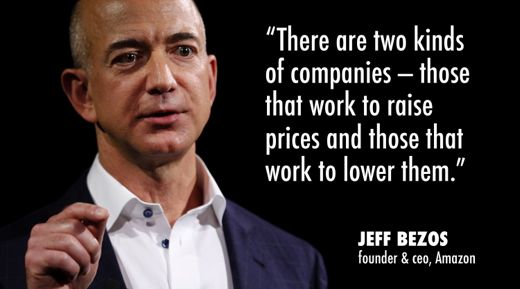Jeff Bezos is right, there are two kinds of companies: those that find ways to raise prices and those that work to lower prices. Both ways can fuel success but many times businesses look at raising prices as a last resort to drive sales. However, it’s probably smarter to follow the path of raising prices to find long-lasting year-over-year sales growth.
As marketers we know there are three and ONLY three strategies to drive sales: (1) Get New Customers to Buy, (2) Get Current Customers to Buy More, More Often, and (3) Raise Prices.
Getting new customers to buy is all about strategies involving newness. We’re talking about introducing new products, entering new markets, launching new advertising campaigns, etc. to gain new customers.
Getting current customers to buy more, more often involves ways to capitalize on the visitation and shopping habits of the customers you already have. Businesses can do this through add-on sales, upsell tactics, prompting visits at a different daypart, etc.
Raising prices is just that, raising the prices on the goods/services you sell.
When was the last time you raised your prices?
If it’s been more than two years, you’re falling behind. Payroll taxes have certainly increased in that time. Most likely the benefits you offer employees have also increased. Not to mention cost of goods sold is sure to have gone up. But your prices haven’t. That means your profit margins are shrinking. (Ouch.)
If it’s been more than five years since you raised your prices then good luck having your customers adjust to higher prices when they’ve become trained to accept a lower price.
Let me be clear, it’s not easy to raise your prices. It’s hard work. Not every company can do it. You have to first earn the right to raise your prices before you can do it.
Earning such a right means you must do some (or all) of the following:
- Sell a unique product/service
- Deliver excellent customer service
- Maintain a market leadership position
- Stand for a higher purpose (i.e. green business practices)
On Monday, Netflix announced its first price increase in three years. New subscribers will be paying up to $2 more per month to stream movies and television shows. (According to Netflix, existing subscribers will continue to pay their current rate for a “generous time period.”)
Netflix has earned the right to raise their prices because the company sells a unique product (original programming like House of Cards and Orange is the New Black) and has exclusive rights to lots of movies and television shows. Netflix also commands a significant leadership position over other video streaming companies.
Chipotle recently said a price increase will go into effect later this year due to increasing food costs. Expect your Chipotle burrito to cost up to 10-cents more come fall. The last time Chipotle raised prices was three years ago… so yes, Chipotle was overdue for a price increase.
However, Chipotle has earned the right to raise their prices because they sell a unique product, maintain a market leadership position, and stand for using organic and natural ingredients.
Amazon has announced a price increase with its Amazon Prime service. Shocking, right? Amazon has built its business model following the strategy of working to lower prices, not raising prices, to drive sales. The next time a customer renews their Amazon Prime membership, they will be paying $99, up from the long-standing $79 yearly fee.
In many ways, Amazon has earned the right to raise its yearly Prime membership fee. It’s a highly unique service that began by giving customer free two-day shipping and now gives customers to ability to stream movies and television shows for free and to borrow Kindle books at no cost.
Starbucks is currently wrestling with raising prices to offset behind-the-scenes expenses associated with rising wholesale milk and green coffee prices. It’s been a few years since Starbucks last raised prices but Starbucks has routinely raised its prices even when not pressured but outside forces. Like Chipotle and Amazon, Starbucks has earned the right to raise prices through serving unique products, delivering great customer service and standing for a higher purpose.
How about your business?
What are you doing to earn the right to raise your prices? And, how would your customer react to a price increase?
My advice is to first earn the right to raise your prices and second, routinely your prices before you are pressured to do so because of shrinking profit margins.
Every year or two, increase your prices by 3% to 4%. If you sell a unique product/service, deliver excellent customer service, maintain a market leadership position, and/or stand for a higher purpose your customers will hardly blink an eye when you charge them a little more.
If you wait five years before raising prices and you hit your customers with an unexpected 18% to 20% price increase, then expect a backlash resulting in fewer customers and lower revenue.
Expect a far greater backlash if you attempt to raise your prices without first earning the right to do so. Pricing power is a privilege that has to be earned, dig?
Did you like this post?
If so, sign-up to receive the monthly Brand Autopsy newsletter and you would’ve already read this. As a bonus for anyone signing up for the newsletter, you’ll receive a two-page tip sheet for encouraging customer advocacy.
